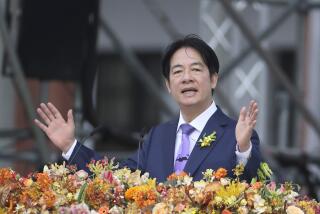U.S., South Korea announce naval, air exercises
- Share via
Reporting from Seoul — The U.S. and South Korea on Tuesday announced a major naval and air exercise for later this month, a show of force aimed at North Korea in response to the sinking of a South Korean warship in March.
The exercise, which will take place in the Sea of Japan and include the aircraft carrier USS George Washington , was announced in a joint statement by Secretary of Defense Robert M. Gates and South Korean Defense Minister Kim Tae-Young after a meeting in Seoul.
“These defensive, combined exercises are designed to send a clear message to North Korea that its aggressive behavior must stop, and that we are committed together to enhancing our defensive capabilities,” the statement said.
The exercises, which officials said would begin July 25 and involve air and naval units, have been in the works since the March 26 sinking of the Cheonan, which killed 47 South Korean sailors and raised tensions on the Korean peninsula. A South Korean-led investigation concluded that the vessel was struck by a North Korean torpedo, though Pyongyang has denied involvement.
Adm. Robert F. Willard, head of U.S. Pacific Command, emphasized that the drills were the first in a series of exercises that would occur in coming months in both the Sea of Japan and the Yellow Sea, in addition to large-scale maneuvers involving U.S. and South Korean ground forces.
“One of our goals is to deter North Korea from further provocations,” Willard told reporters. “Whether or not this series of exercises singly will deter North Korea remains to be seen, but it is a first step.”
He said that North Korea’s sometimes brazen actions over the years, including the firing of ballistic missiles and other acts, raised questions about whether the secretive regime in Pyongyang will actually be deterred from similar acts by a show of force. But he noted that large-scale exercises have not been undertaken in recent years in response to previous moves by North Korea.
The goal of the U.S.-South Korean response “is to send a very clear signal that this is not business as usual. Their behavior needs to change,” he said.
In remarks to reporters earlier in the day, Gates also emphasized the difficulty of putting effective pressure on North Korea, whose relations with the outside world often appear aimed at creating periodic crises as a way of creating leverage.
“North Korea is about as isolated as a country can get,” Gates said. “I think this is an ongoing challenge that has to be managed over a period of years, and I think that the pressure continues to build slowly on the north.”
The initial drills later this month will involve 20 U.S. and South Korean ships and submarines, as well as 200 aircraft, including the advanced F-22 fighter, which will be flying training missions in and around Korea for the first time, according to a statement issued by the U.S. and South Korean militaries.
Analysts here said the high-profile visit by both Gates and Secretary of State Hillary Clinton, who is arriving in Seoul on Wednesday, was a reminder that U.S. officials stand behind a key Asian ally’s quest to avenge North Korea’s March sinking of a South Korean warship.
“For the U.S., the visit signals a critical commitment both to your adversaries and your alliance partner,” said Daniel Pinkston, North East Asia Deputy Project Director fro the nonprofit International Crisis Group. “They want to shore up their alliance with Seoul, while reminding Pyongyang that their commitment is credible and formidable.”
Yet experts say that Washington must walk a fine line. Its goal is to move past the Cheonan disaster and focus on bringing North Korea back to the six-party anti-nuclear talks, analysts said.
“The United States wants to clinch this issue and move on,” said Chung Young-chul, a professor at Sogang University’s Graduate School of Public Policy in Seoul, “but it has to be considerate of its ally’s position.”
Others warn that a spurned South Korea has other military options that could further inflame tension on an already edgy Korean Peninsula. “South Korea has already ramped up its defense spending and is deploying a new missile that can strike targets in China,” said Pinkston.
“So if Seoul gets the feeling its being abandoned or that its U.S. alliance is not reliable, it’s prepared do things for its own defense.”
More to Read
Sign up for Essential California
The most important California stories and recommendations in your inbox every morning.
You may occasionally receive promotional content from the Los Angeles Times.















